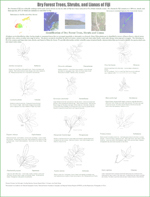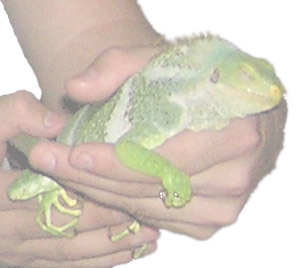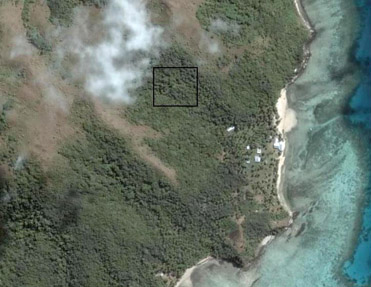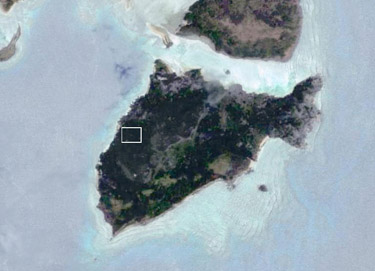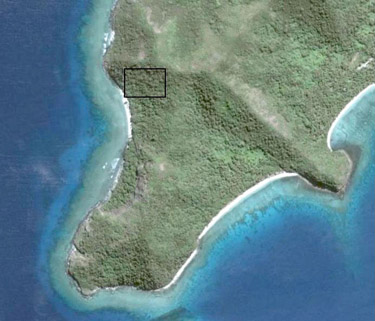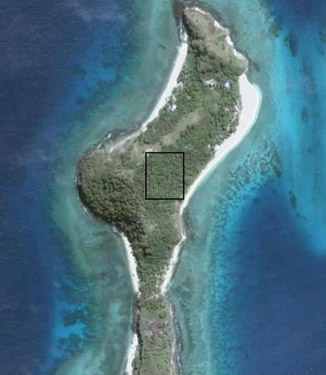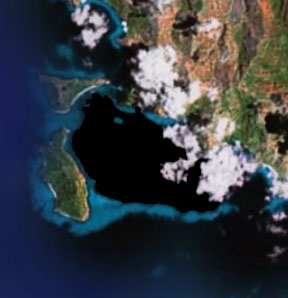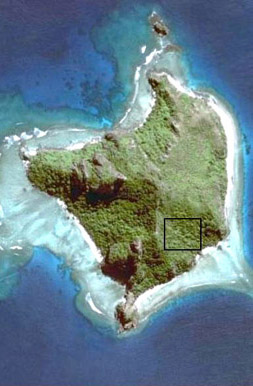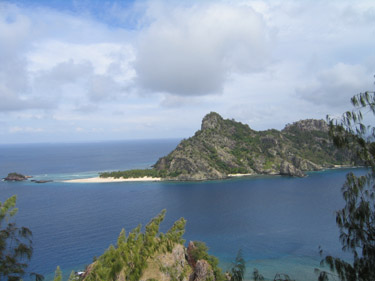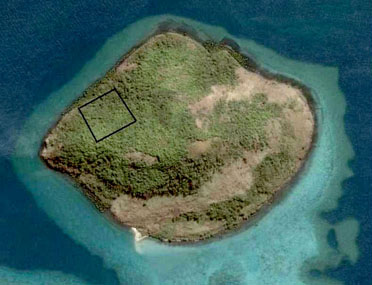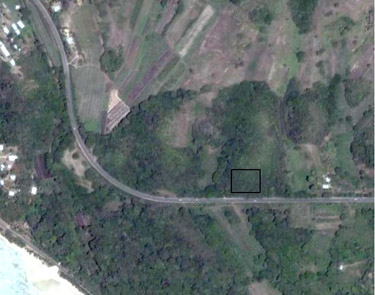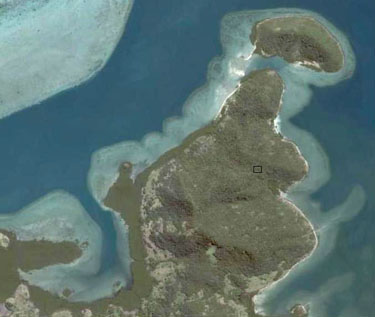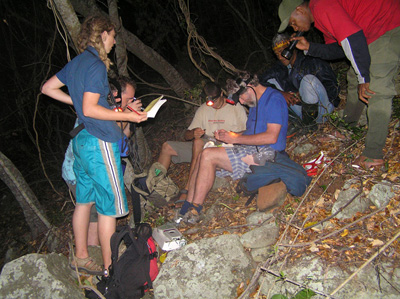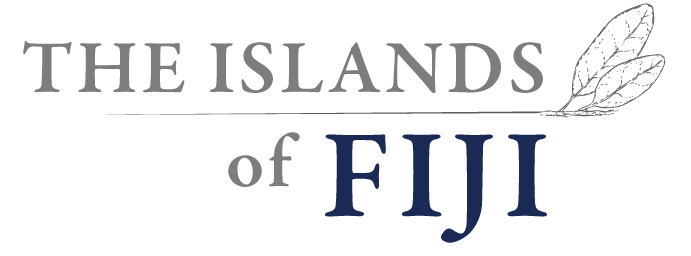
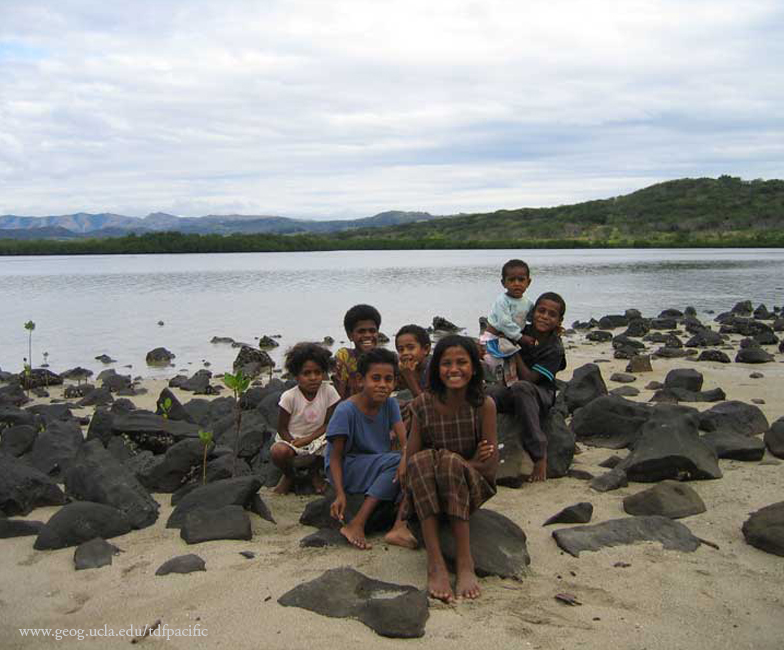
THE RESEARCH
Fiji consists of approximately 300 islands, the oldest of which dates back to 40 million years (Rodd 1993). The two largest islands in Fiji are Viti Levu (10,338 km2) and Vanua Levu (5,535 km2) characterized by a rugged mountainous interior and coastal plains. Precipitation patterns fluctuate between the wet months of December to April and dry months of May to October. Seasonal precipitation and a rainshadow caused by high mountains results in a dry side of Fiji that once contained large expanses of tropical dry forest. Fiji’s tropical dry forests probably had its widest distribution some 18,000 years ago during the glacial maximum, when the climate was drier and the sea level was approximately 100 m lower than present (Gibbons & Clunie 1986; Southern 1986). During that time the Mamanuca and Yasawa groups were part of Viti Levu and dry forests and savannas where probably more extensive on Viti Levu and central Vanua Levu (Gibbons & Clunie 1986). Before the arrival of humans, tropical dry forest in Fiji occurred on islands in the Mamanuca and Yasawa groups and the western or rain shadow side of Fiji’s two largest islands, Viti Levu and Vanua Levu (Smith 1979 to 1996).
The tropical dry forests in Fiji have a long history of anthropogenic disturbance beginning with the arrival of the first native Polynesians and Melanesians over 3500 years ago (Hunt 1981; Diamond 1988). Large areas of tropical dry forest were converted to savannas due to burning and before European contact the tropical
dry forest region was extremely degraded (Rolett & Diamond 2004). After European contact, the tropical dry forest region was further degraded by the introduction of non-native tree species and commercial agriculture (Keppel 2001). Lowlands on the dry side of Fiji were converted to sugar cane plantations in the 19th century and laborers from southern India were brought to Fiji by the English colonists to work these large plantations. Today, tropical dry forests of Fiji have been classified as Critical/ Endangered (WWF & IUCN 1995, Keppel 2005).
The native dry forest flora contains a number of species with widespread distribution in the Pacific. Canopy trees such as Planchonella grayana, Mallotus tiliifolius, Gyrocarpus americanus, Psydrax odorata and Antirhea inconspicua all have wide distributions in the Pacific and are typical of drier forests (Fensham 1995; Whistler 2004). The liana species Derris trifoliata, Malaisia scandens, and Mucuna gigantea are extremely widespread in the Pacific.
Study Sites:
(Refer to map for Study Site links.)
Nine study sites were selected and surveyed during July and August 2004 and August and October 2005: Monu, Nanuya Balavu, Naviti, Tavewa, Sawa-i-Lau, Yanuca, Vatia, Macuata, and Yadua Taba.
Location: TAVEWA
Tavewa is a relatively small island in the Yasawas that contains four fragments of dry forest. We surveyed the largest fragment above the Coral View Resort. This forest was dominated by one species (Diospyros phlebodes). The forest has been disturbed by cutting for fire wood and timber but there is good regeneration of species in the understory.
Location: SAW-I-LAU
The island of Saw-I-Lau is a heavily forested limestone island, an anomaly for the Yasawas group, which are all of volcanic in origin. The island is also an anomaly because it is almost completely forested due to the sharp and vertical limestone karst formations which make movement around the island extremely difficult. The site contains flooded caves which are a popular tourist attraction for travelers. The island also contains one of the largest Flying Fox colonies in the Yasawas. Here, we surveyed a steep forest on limestone karst. The forest is composed of primarily of the deciduous trees Gyrocarpus americanus and Pongamia pinnata.
Location: NAVITI
Naviti is one of the largest islands in the Yasawas and contains some of the best tropical dry forest in the Yasawas. Most of the island is covered by grassland and the non-native Leucaena leucocephala forest, but a number of small dry forest fragments occur on sleep slopes protected from fire, agriculture, and people. The southern tip of Naviti contains native dry forest which is very difficult to reach. This was the richest dry forest site in the Yasawas and contained the nine plants endemic to Fiji. There was evidence that Leucaena leucocephala was invading on the edge of the fragment. Forest fragments on Naviti should all be surveyed and there is high potential for finding new species on the island.
Location: NANUYA BALAVU
Nanuya Balavu is home to the Manta ecotourism resort named after the large Manta Rays that swim in a near by deep water channel. There are no villages on the islands which is largely forested by mature native trees. However, goats graze down the understory and there is almost no regeneration of native plants. Leucaena leucocephala is invading the native forest and a quick resource management push with a machete would solve the problem. If the non-native animals (goats, dogs, cats) were removed this would be an excellent site for the reintroduction of the Crested Iquana given the sincere interest in ecotourism at the Manta Resort.
Location: YADUA TABA
Yadua Taba is located of the island Yadua. Yadua Taba contains a number of fragments of native forest and contains the world’s largest population of Crested Iguanas. Goat have been removed from the island and there is an active non-native species removal and fire suppression program. The forest contains a high richness of native trees and is dominated by Vavaea amicorum which is an important food resource for the Crested Iguana. The Yadua Taba site is managed by rangers from Yadua is partnership with the National Trust of Fiji Islands with support from the Taronga Zoo, Australia.
Location: MONU
Monu Island is a small (67 ha) uninhabited island in the Mamanuca group. The island is located next to Monoriki island which was made famous by the movie ‘Castaway’ and contains the Endangered Crested Iguana. Fires and grazing by goats have restricted forest to steep slopes on volcanic rock at the base of the island. Surveys were done in a five hectare fragment at 40 m elevation. The forest contains 19 species but only two species endemic to Fiji. There is very little regeneration of native plants in the understory due to goats. My parents were field assistants at this site and endured a lot of climbing and waiting for transportation.
Location: MACUATA
Macuata is a volcanic island in north Viti Levu. Native forest persists on the north side of the island on steep slopes. The forest contains the Crested Iguana. Surveys were established in a 5 ha fragment at 65 m. This small island contains a high species richness of native and endemic plants due to it’s close proximity to the island of Viti Levu. The forest is managed by the local village, the World Wildlife Society, and the University of the South Pacific have research protects on the island.
Location: YANUCA
Yanuca is located south of the village Voua on the northern side of the Queens highway. A native forest persists on limestone outcrop near the road. The forest fragment is 3.7 ha and at 27 m elevation. The forest contained the second highest richness of native trees (22 species) and a high number of endemic species (9 species). The Yanuca site is protected by the local chief and has a joint conservation collaboration with Cuvu and Tuva Districts, Fiji government, Shangri-La’s Fijian Resort, and OISCA Fiji. The Management plan is financial supported by NZ AID, Packard and MacArthur Fountations, Darwin Initiative, and Shangri-La’s Fijian Resort. This site has excellent potential as a conservation area and ecotourism.
Location: VATIA
Vatia is an isolated penisula in north Viti Levu. Although non-native trees dominate the region fragments of native forest occur on rocky substrates in gullies isolated from fire. Surveys were undertaken on a gentle slope. The forest contained the highest species richness in Fiji (33 sp.) and a high number of endemic species (9 sp.). The forest also contained a high density of the endemic trees Cynometra falcata and Flacourtia subintegra which are rare in other areas. Although the forest receives more annual precipitation than the Yasawas, this would be an excellent area to undertake large scale restoration efforts. There is currently discussion to create fences to exclude cattle and goats but there is no management plan for the forest.
CONSERVATION
Conservation efforts have been made in Fiji to preserve sensitive environments including various rainforests, coral reefs, and beaches. Unfortunately, Fiji’s most vulnerable environment, the dry forest, has not received the necessary attention it deserves (Keppel 2005). There is only one site in our study, Yadua Taba, which is currently protected at a national level. All other fragments are still threatened by fire, grazing, and invasion of non-native species. A high priority should be placed on conserving fragments on Viti Levu, islands with the Crested Iguana, and the Yasawas group. The island of Viti Levu had the highest species richness and endemism of all native forests; however, there are very few large native forests outside of the Vatia peninsula. Tropical dry forest of Fiji are also home to the Critically Endangered Fijian Crested Iguana (Brachylophus vitiensis) which is now restricted to three populations on the islands of Macuata, Yadua Tabu, and small population on Monuriki (Harlow & Biciloa 2001).
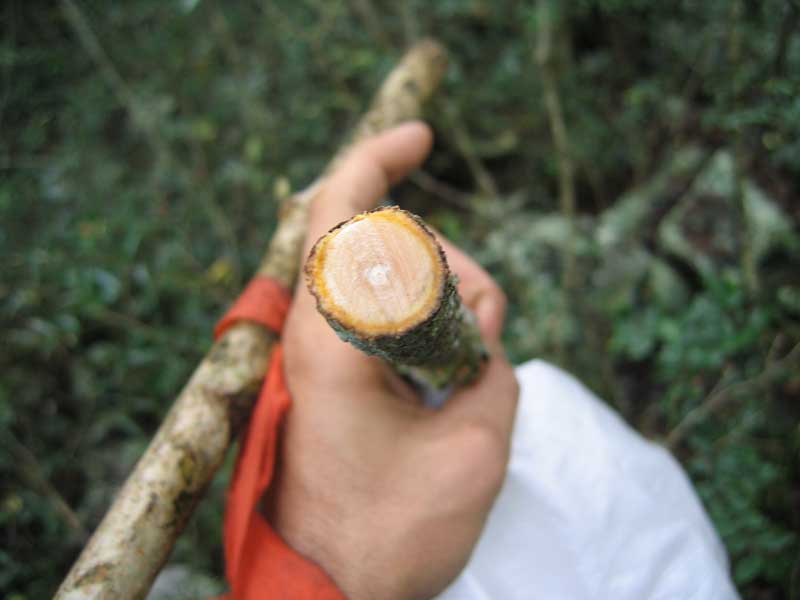 Dry forest that receive less than 2000 mm annual precipitation and conform to Murphy and Lugo’s (1986) definition of tropical dry forest are restricted to approximately 16 fragments greater than 10 ha in the Yasawas group based on preliminary assessments from the field and Landsat ETM+ imagery. There are currently no detailed surveys of the floristic composition of islands in the Yasawas, and they may contain a number of dry forest endemic species. There is also high potential for conservation of remaining forest fragments in the Yasawas due to a recent increase in ecotourism on the islands over the last 5 years. Systematic floristic inventories of these remaining dry forest fragments are needed.
Dry forest that receive less than 2000 mm annual precipitation and conform to Murphy and Lugo’s (1986) definition of tropical dry forest are restricted to approximately 16 fragments greater than 10 ha in the Yasawas group based on preliminary assessments from the field and Landsat ETM+ imagery. There are currently no detailed surveys of the floristic composition of islands in the Yasawas, and they may contain a number of dry forest endemic species. There is also high potential for conservation of remaining forest fragments in the Yasawas due to a recent increase in ecotourism on the islands over the last 5 years. Systematic floristic inventories of these remaining dry forest fragments are needed.
Diamond J 1988. Express train to Polynesia. Nature 336: 307-308.
Gibbons JRH, Clunie G.A.U 1986. Sea level changes and Pacific prehistory. The Journal of Pacific History 21: 58-82.
Harlow PS, Biciloa PN 2001. Abundance of the Fijian crested iguana (Brachylophus vitiensis) on two islands. Biological Conservation 98: 223-231.
Hunt TL 1981. New evidence for early horticulture in Fiji. The Journal of the Polynesian Society 90: 259-266.
Keppel G 2001. Low genetic variation in a Pacific cycad: conservation concerns for Cyas seemannii (Cycadaceae). Oryx 36: 41-49.
Keppel G, 2005. Fiji’s tropical dry forest-an ecosystem on the brink of extinction. Melanesian Geo 3: 22-25.
Rodd JA 1993. The petroleum potential of Fiji, Southwest Pacific. Suva, Fiji, South Pacific Geoscience Commission.
Rolett B, Diamond J 2004. Environmental predictors of pre-European deforestation on Pacific Islands. Nature 431: 443-446.
Smith AC 1979. Flora Vitiensis nova: A new flora of Fiji (spermatophytes only). Vol. 1. Hawaii, USA, Pacific Tropical Botanical Garden.
Smith AC 1981. Flora Vitiensis nova: A new flora of Fiji (spermatophytes only). Vol. 2. Hawaii, USA, Pacific Tropical Botanical Garden.
Smith AC 1985. Flora Vitiensis nova: A new flora of Fiji (spermatophytes only). Vol. 3. Hawaii, USA, Pacific Tropical Botanical Garden.
Smith AC 1988. Flora Vitiensis nova: A new flora of Fiji (spermatophytes only). Vol. 4. Hawaii, USA, Pacific Tropical Botanical Garden.
Smith AC 1991. Flora Vitiensis nova: A new flora of Fiji (spermatophytes only). Vol. 5. Lawai, Hawaii, USA, Pacific Tropical Botanical Garden.
Smith AC 1996. Flora Vitiensis nova: A new flora of Fiji (spermatophytes only): Comprehensive indices. Hawaii, USA, Pacific Tropical Botanical Garden.
Southern W 1986. The Late Quartenary environmental history of Fiji. Unpublished PhD thesis, Australian National University, Canberra, Australia.
WWF and IUCN. 1995. Centres of plant diversity. A guide and strategy for their conservation. Vol. 2. Asia, Australasia and the Pacific. Cambridge, UK. IUCN Publication Unit.
WorldClim (2005) [WWW document]. URL http://biogeo.berkeley.edu/worldclim/worldclim.htm (accessed 18 November 2005).
Acknowledgments
We would like to thank the National Trust of Fiji and especially local villages and chiefs for permission to do field research in Fiji. Craig Morely, Peter Harlow, Pita Biciloa, Clare Morrison provided technical support and Robert Gillespie, Kathy Gillespie, Suzanne Morrison, and Carolina Sanchez for assistance in field research. Gunnar Keppel helped with species identification and was a joy to work in the field with. Marika Tuiwawa at the Herbarium at the University of the South Pacific was very kind and helpful.
Thank you to Google Earth for all the plot images.
